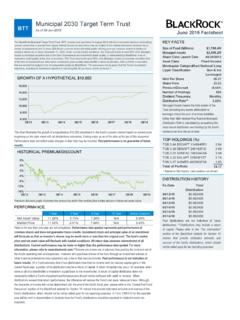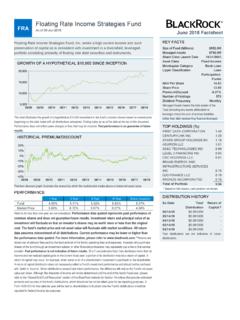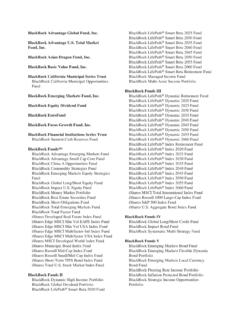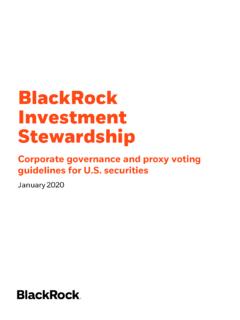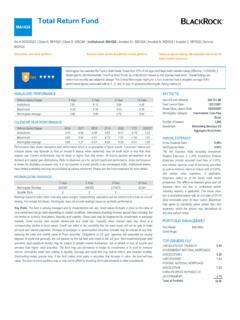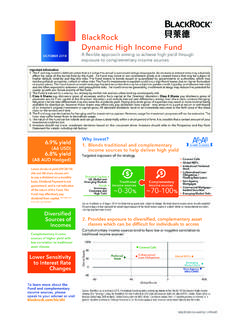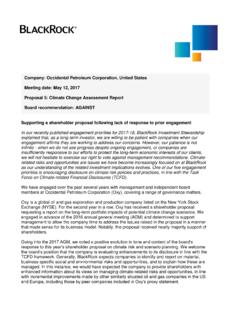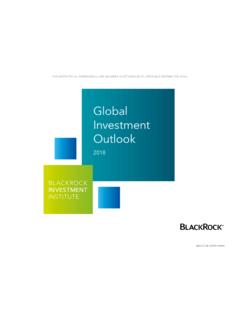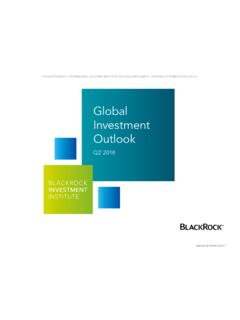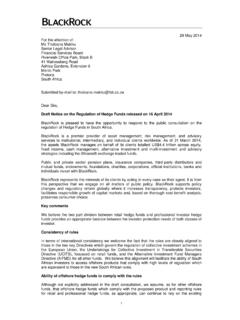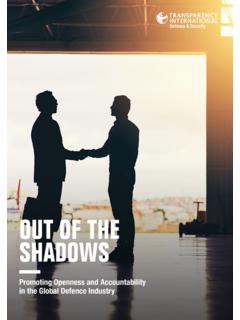Transcription of Taking Market-Based Finance Out of the Shadows
1 VIEWPOINTFEBRUARY2018 Taking Market-Based Finance Out of the ShadowsDistinguishing Market-Based Finance from shadow BankingWe would like to thank Nellie Liang, Miriam K. CarlinerSenior Fellow, Economic Studies at Brookings for her thoughtful contributions to this opinions expressed are as of February 2018 and may change as subsequent conditions NovickVice Chairman Joanna CoundEMEA Head, Global Public Policy GroupAlexis RosenblumGlobal Public Policy GroupJeff RosenbergChief Fixed Income StrategistThe term, shadow banking,was coined in 2007 to describe products and activities that were bank-like but existed outside the bank regulatory then, shadow banking has become a catch-all for non-bank Finance . This overly broad use of the term misrepresents the risks associated with the vast majority of non-bank Finance that is beneficial to the real economy, does not entail bank-like risks, and (most importantly) contributes to financial stability rather than threatens it.
2 At a time when policy makers are reviewing whether post-crisis regulatory reforms properly balance the objective ofmitigating systemic risk without impeding economic growth, a distinction must be drawn between capital invested in the real economy (either directly or through commingled vehicles), which should be called Market-Based Finance ,and shadow banking, which should refer to entities that have material asset-liability mismatches and the potential to place taxpayers on the hook through access to official sector lack of a clear distinction between shadow banking and Market-Based Finance can hinder regulators ability to fully monitor and address risk in the financial example, there are inconsistencies between data produced by the Financial Stability Board (FSB), which show shadow banking assets that could create financial stability risk increasing since 2007, and the FSB s communications to the G20, which state that systemic risks from shadow banking have declinedover the same the term shadow banking to registered investment companies is particularly inappropriate as the word shadow could be interpreted as implying insufficient regulatory oversight, or disclosure.
3 US Treasury Report on Asset Management & Insurance RegulationOct. 26, 2017In this Today s shadow banking system is a shadow of its pre-crisis self, thanks to global reforms. Yet, the FSB s data creates an inaccurate picture that shadow banking is increasing due to its overly broad definition. The term, shadow banking, should be limited to entities that have material asset-liability mismatches, significant leverage, and direct connections to traditional banks, which can create implicit access to official sector backstops. Most non-bank Finance provides clear benefits to the real economy without introducing bank-like risk, and should be classified as Market-Based Finance . The current practice of calling so many different things shadow banking limits policy makers abilities to fully monitor and address financial stability risks.
4 A continuum can help differentiate Market-Based Finance from shadow banking. We recommend amending the existing regulatory definitions of shadow banking to account for how activities and entities are funded. Investment funds and asset managers should be removed from measures of shadow banking and reclassified into a new measure of Market-Based seeming contradiction is highlighted in Exhibit 1. We believe the FSB s statements are accurate, but its data on shadow banking obscures the decline in risk due to an overly broad definition. The recognition that more precise distinction between shadow banking and Market-Based Finance is needed has led to an emerging of shadow BankingThe term, shadow banking, was first coined in 2007 by Paul McCulley, an economist at PIMCO. McCulleydefined the shadow banking system as the whole alphabet soup of levered up non-bank investment conduits, vehicles, and structures.
5 5 For years, a buildup of risk in the shadow banking system developed from efforts of traditional banks to reduce balance sheet exposures in pursuit of higher returns. In effect, an entire ecosystem developed to facilitate this outcome. Financial engineering fostered new uses of previously benign structures to embed greater leverage, reliance on short-term wholesale funding, and a variety of risky the traditional banking system, which was funded by customer deposits that were backstopped by access to central bank liquidity, the shadow banking system was funded primarily through reliance on commercial paper markets. However, similar to the traditional banking system, shadow banks were susceptible to runs. Importantly, the shadow banking system was directly connected to the traditional banking of shadow banking entities under this definition include structured investment vehicles (SIVs) and a variety of other off-balance sheet conduits that were levered and reliant upon short-term wholesale funding markets to Finance the purchase of longer-dated assets.
6 Generally speaking,these structures issued short-and/or medium-term debt to Finance the purchase of longer-dated assets. Oftentimes, a bank sponsor would provide implicit or explicit liquidity support to the vehicles as a backup in case there was a problem rolling over funding. Under the accounting and capital regulations at the time, the capital charge to Finance loans in this manner was lower than the capital charge associated with holding the loans directly on the bank s balance banking entities often had tranches associated with different risk levels, some of which were sold to investors. However, portions of these assets (often the most risky tranches) were retained by bank sponsors, meaning that the banks creating these products did not fully extricate themselves from the risks associated with became painfully apparent, there were weaknesses in this system that led to billions in write-downs on banks balance sheets between 2007 and losses demonstrated the downside of a classic regulatory arbitrage.
7 The shadow banking system permitted bank-like and bank-connected entities to benefit from access to official sector backstops through explicit and implicit forms of liquidity support. The resulting moral hazard and a lack of adequate regulation of banks exposure to shadow banking entities contributed to excessive risk response, global regulators adopted reforms including changes to accounting and consolidation rules, as well as securitization reforms, in addition to lessons learned by market participants, have by all accounts reduced the shadow banking system to a shadow of its former self. As shown in Exhibit 1, in July 2017, the FSB declared: financial stability risks from the toxic forms of shadow banking at the heart of the crisis no longer represent 2 Exhibit 1: Contradictions between FSB Data and G20 CommunicationJuly 2017 FSB Letter to G20 Source: FSB, Assessment of shadow Banking Activities, Risks and the Adequacy of Post-Crisis Policy Tools to Address Financial Stability Concerns (Jul.)
8 3, 2017) ( shadow Banking Assessment Report ), graph graph represents the FSB s narrow measure of shadow series of measures are eliminating toxic forms of shadow banking and transforming the remaining into resilient Market-Based decade ago, enormous risks were built up outside the core banking system and away from effective supervision with devastating impact on the real economy. In 2013, the G20 agreed the shadow Banking Roadmap, to implement its comprehensive framework to strengthen oversight and regulation of shadow banking. A decade on, as a result of these measures, the financial stability risks from the toxic forms of shadow banking at the heart of the crisis no longer represent a global stability risk. The remaining activities are now subject to policy measure which reduce their risks and reinforce their benefits, allowing for more diverse and resilient forms of Market-Based 2017 FSB shadow Banking Assessment ReportUSD TrillionsSource: Chairman Mark Carney, FSB Letter to G20 Leaders (Jul.
9 3, 2017) ( July 2017 G20 Letter ). GR0218G-424315-1350418a global stability risk. We agree with this statement. However, data published by the FSB presents a different picture. Specifically, the FSB s July 2017 shadow Banking Assessment Report showed an increase in shadow banking assets since 2007, which suggests the opposite conclusion, as shown in Exhibit 1. Casting a Wide NetWhat accounts for the discrepancy shown in Exhibit 1 ( , shadow banking assets have increased since 2007 but the FSB statements indicate shadow banking risks have decreased during the same period)? In our view, the FSB s data obscures the decline in shadow banking due to an overly broad definition. This definition emanates from an effort to be comprehensive in the initial years following the crisis, but this definition is no longer fit for purpose.
10 In its initial recommendations to strengthen regulation and oversight of shadow banking , the FSB laid out a two-step approach that would begin by casting a wide net, followed by a narrowing exercise to focus on entities and activities that present systemic casting a wide net, the FSB did not distinguish shadow banking from other forms of non-bank Finance . As a result, the FSB defined shadow banking as credit intermediation involving entities and activities outside the regular banking system. In employing this broad approach, the initial definition of shadow banking gave the impression that all non-bank credit intermediation was unregulated and presented financial stability respect to the asset management industry, this led to proposals that sought to apply bank-like regulation to asset management products and activities, as well as asset managers education and constructive dialogue has largely led to the conclusion that bank-like regulation is not appropriate for asset managers or their products,13some regulators still believe such policies would mitigate perceived financial stability risks.
